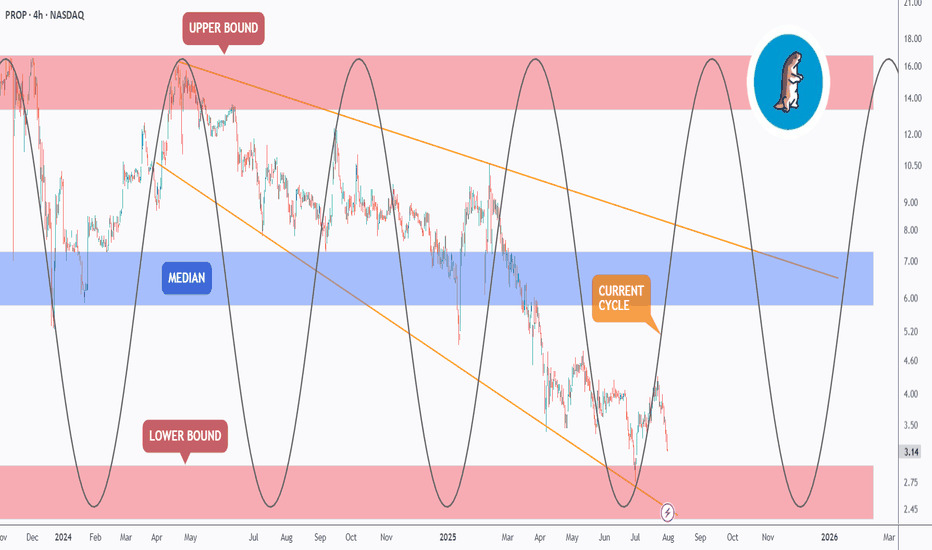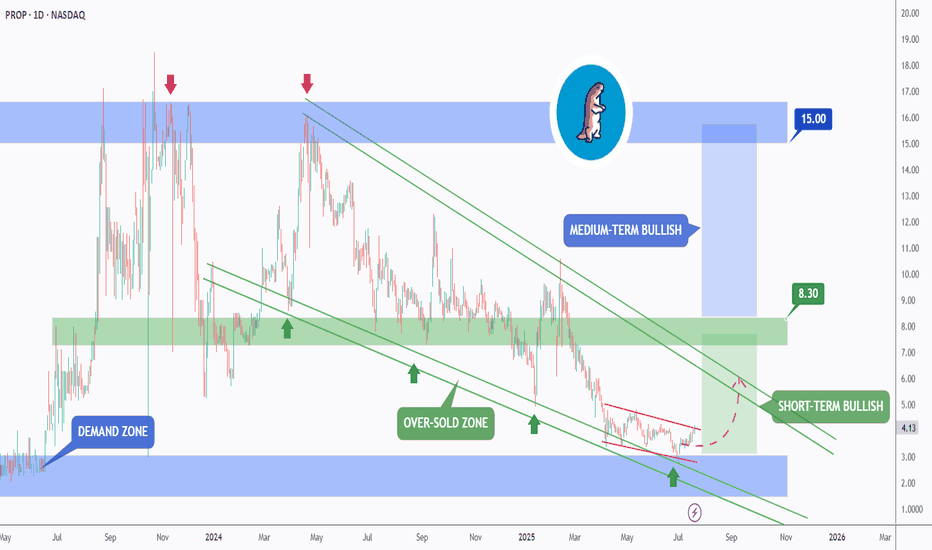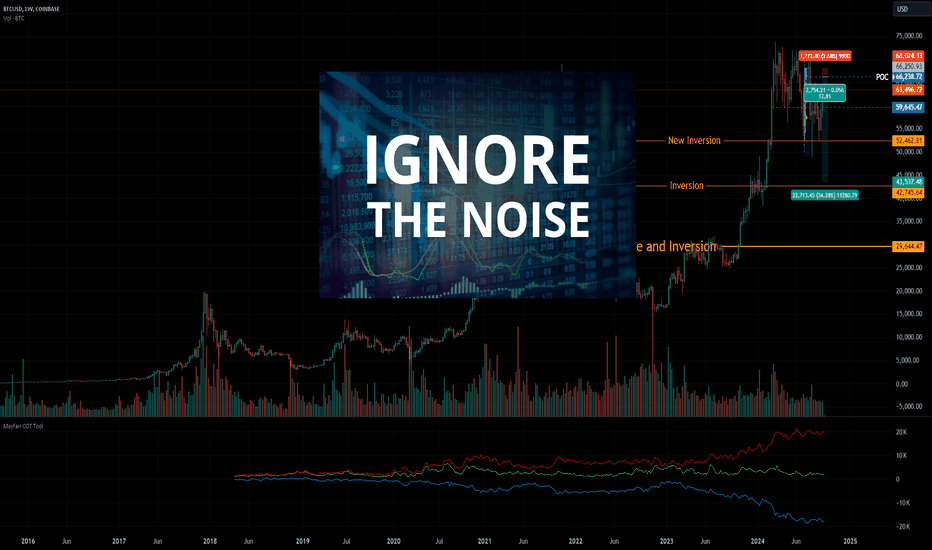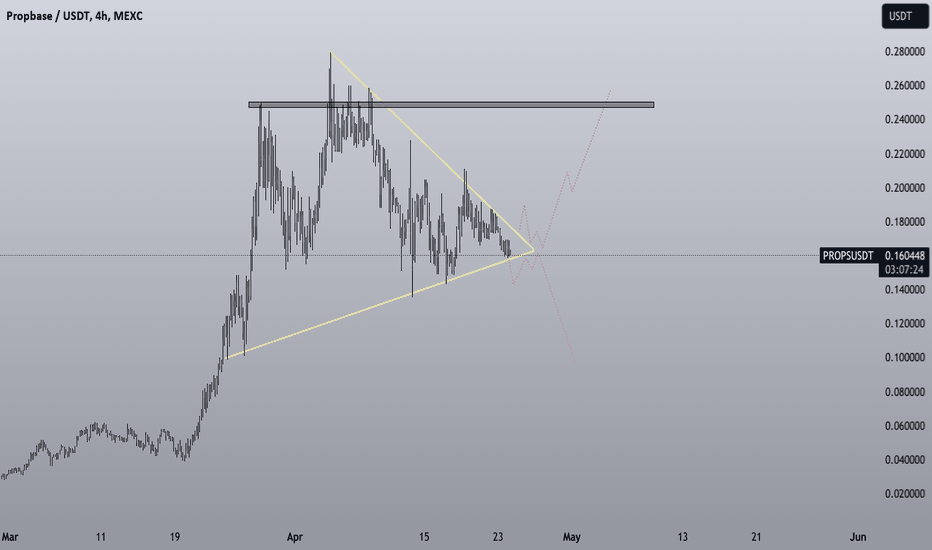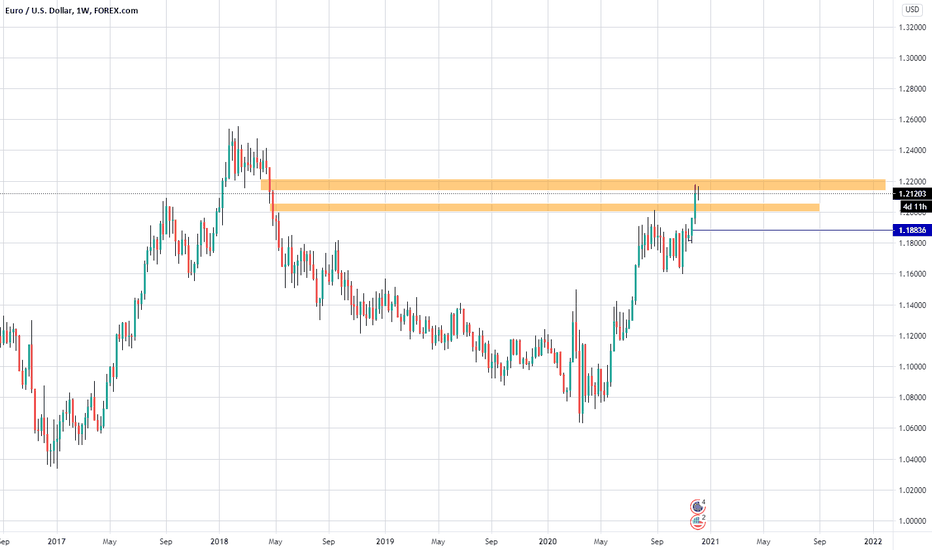PROP - Riding the Cycle? The Next Wave May Just Be Starting!Markets move in cycles; and PROP is no exception.
If you’ve been following our previous analyses, you’ll recognize the accumulation zone we highlighted earlier. Well, this updated chart adds another layer: the cyclical rhythm of price action.
🔁As shown, PROP has been moving in clearly defined waves, bouncing between key zones with consistency. The current cycle appears to have bottomed — once again — inside the lower bound, where strong demand continues to hold.
We’re now in the early phase of what could be a fresh bullish cycle. If the rhythm plays out as before, the path of least resistance could take us toward the median zone ($6.5 - $7.5) and possibly all the way back to the upper bound ($15 - $17) by late 2025 or early 2026.
🔍 Supporting Fundamentals
While the chart speaks volumes, the fundamentals back it up:
Energy demand is surging globally, fueled by AI, data centers, and electric infrastructure — all of which require massive power capacity.
Oil and gas remain essential in this transition phase, especially with renewable infrastructure still years away from matching base-load demand.
PROP (Prairie Operating Co.) controls 65,000 acres in the DJ Basin — one of the most productive oil regions in the U.S. With advanced drilling tech and low-cost operations, PROP is well-positioned to ride out volatility and capitalize on rising demand.
🎯 Key Zones to Watch
- Support: $2.5–$3
- Median target: $6.5–$7.5
- Macro resistance: $15–$17
📌 We’re not just seeing structure — we’re seeing rhythm, confluence, and timing align.
If this cycle continues to play out, PROP might just be preparing for its next major wave.
Are you ready to catch it?
🧠 Previous posts and technical breakdowns are attached for full context.
➡️ As always, speak with your financial advisor and do your own research before making any investment decisions.
📚 Always follow your trading plan => including entry, risk management, and trade execution.
Good luck!
All strategies are good, if managed properly.
~ Richard Nasr
PROP
A Sleeping Giant in the Energy Sector?While everyone’s chasing the next hot AI stock, a quiet opportunity might be taking shape in the energy sector; and it could be a big one.
🔋 As AI data centers explode in size and number, the demand on our power grid is rising fast. Nuclear is still years away, and renewables are struggling to scale in time. That leaves oil and gas as the most reliable players; and one U.S. company may be perfectly positioned to ride that wave.
📊 Technical Analysis
NASDAQ:PROP PROP has been in a steady downtrend, moving within a falling wedge pattern (marked in green). Right now, it’s retesting the bottom of that wedge, typically where things get oversold.
Even more interesting, PROP bounced off a major monthly demand zone last week, a signal that buyers may be stepping in.
In the short term, if the blue demand zone holds, we could see a push toward the $7 mark, which lines up with the top of the wedge.
But to really confirm a medium-term reversal, we’ll need a clean break above the $8.3 resistance. If that happens, the door could open to a rally toward $15, a key level from early 2024.
🛢️ Why PROP? A Hidden Play With Room to Run
Prairie Operating Co. (NASDAQ: PROP) isn’t your typical small-cap oil stock. They own 65,000 acres in Colorado’s DJ Basin and use modern drilling tech to stay lean and efficient. That means they can still make money even when oil prices dip.
As energy demand continues to climb, PROP could be sitting in the sweet spot , especially with the world so focused on tech stocks. But behind every AI boom is a growing energy need, and companies like PROP are the ones powering it.
One well-known Wall Street firm recently gave PROP a Buy rating with a $21.75 price target; that’s a potential 281% upside from where it stands today. And that’s not even counting the potential boost from energy-friendly policies under the current administration.
📌 One to Watch in 2025
PROP might just be one of the most under-the-radar energy plays going into the new year.
The biggest moves often start quietly; and this one has all the ingredients to surprise.
➡️ As always, speak with your financial advisor and do your own research before making any investment decisions.
📚 Always follow your trading plan => including entry, risk management, and trade execution.
Good luck!
All strategies are good, if managed properly.
~ Richard Nasr
How to Secure Prop Firm Funding: Proven Strategies to Pass1️⃣ How to Secure Prop Firm Funding: Proven Strategies to Pass Challenges 📈
Introduction ✨
Securing prop firm funding opens the door to trading substantial capital and achieving financial freedom. However, passing these evaluations requires meticulous strategy, disciplined execution, and smart risk management. This article provides actionable strategies, optimized trading setups, and insights on leveraging AI to ensure you successfully navigate and pass your prop firm challenges.
Understanding Prop Firm Evaluations 📊🔍
Prop firm challenges typically include specific trading objectives:
💰 Profit targets (8–10% within 30 days)
⛔ Daily loss limits (usually 5%)
📉 Maximum drawdown limits (typically 10%)
💡 Tip: Print the rules and display them at your workspace to avoid rule breaches.
Focus on One High-Probability Strategy 📌🎯
Consistently profitable traders use one rigorously tested strategy. For example, a popular setup:
🔄 Liquidity Sweep: Wait for price to clear stops above recent highs or lows.
⚡ Market Structure Break (BOS): Enter after price breaks and confirms a new trend.
📥 Entry: Order block (OB) or Fair Value Gap (FVG).
Example Trade:
🔗 Pair: EUR/USD
🔽 Entry: OB after sweep at 1.0800
🛑 Stop Loss (SL): 1.0820
🎯 Take Profit (TP): 1.0740
📊 Risk-to-Reward Ratio (RRR): 3:1
Start Small, Think Big 🧠🌱
Initially, risk only 0.5% per trade to maintain psychological comfort and buffer against drawdowns. Increase risk gradually once you have a profit cushion.
Leverage AI Insights 🤖📊
Modern traders enhance decision-making using AI-driven tools:
🟢 AI indicators for real-time liquidity detection
🔵 Predictive analytics for entry confirmations
Efficient Risk Management 🛡️⚖️
Set daily and weekly risk limits. For instance:
⏳ Maximum daily risk: 1%
📅 Weekly drawdown cap: 3%
Practical Example:
💵 If trading a $100,000 account, never risk more than $1,000 in a single day.
Journaling for Improvement 📒📝
Record every trade’s rationale, execution details, and outcome. This fosters accountability and improvement.
Conclusion ✅
Securing prop funding isn't about luck but disciplined, strategic execution. Optimize your trading, leverage technology, and strictly manage risk to ensure long-term success. 🏆
How to start as a trader, and have a good chance of making it.I have written on this subject before, see my signature.
There is more though.
If you are starting out, there is a LOT you need to know. I will start with some basics. Some of them you may scoff at, and say I am wrong, but I can assure you I am not. Truly.
Read my previous post here:
After reading that, you may well think again about trying trading. If the idea of taking a long time (at least 6-8 months for a natural) to learn something bothers you, or you need to make money NOW , then I would advise you that trading is not for you, or not yet, at least. For a start, being impatient is the absolute worst trait you can possibly have.
If you still want to continue, then I can help you.
You will have to have the patience to read a lot of words.
1. Pick an instrument you want to trade. If you are a stock trader it's different, because you should be trading the stocks that are "in play" that day. Typically I'd recommend the day after results/news came out, rather than the actual day itself, when you are starting out. Why? It's easier to see the way the price is trending, and the trend is your friend.
If you are not trading stocks, I would recommend either a share index like SP500 or NASDAQ or FTSE or DJ30, or an FX pair that is NOT EURUSD. Oil and Gold are Ok too. Crypto I would not recommend for a beginner.
Reasons: Let's start with Crypto. The big players can pay the exchanges, perfectly legally, to see your orders and stop-loss levels. This is not a personal vendetta against you. They can see the aggregate levels of millions of traders, and thus learn how to trigger bulk stop losses to make money off you directly. This is not legal in the other markets. The same manipulation is still possible, but not to the same extent.
Why not EURUSD? It's the biggest and most popular FX pair, so the most big-boy games are played there, see the Crypto explanation above. The banks have access to millions of client positions, so they can see when their clients get squeezed, and they assume (usually correctly) that other banks' clients will be in the same boat.
Why the rest? Tight spreads are common (look it up if you don't know what a spread is). Banks exert less control (though still some).
Why pick one instrument? because you need to LEARN how it trades. This may seem weird, but each has its own character, and if you trade more than one, you won't notice it. You may be saying "But one pair will only give a few opportunities each day/week, why not trade more than one? This is related to a recurring theme in the way I teach: "Fewer trades, more quality trades, higher confidence trades". If you properly learn the character of one pair, then it's better than guessing in 3-4 pairs. A LOT better for your profits, and that is what counts.
Next I am going to say only risk a max of 1% of the account per trade, and again your reaction might be "How am I going to make decent money with tiny risk like that?" Do the maths. If you do four trades a week(yes really just 4 a week), two wins and 2 losses at 2.5R (R is risk reward, so you lose max of 1%, and make 2.5% if you are right, then you will be up 3% in the week. 3% compounded over a year is 330%. Wow. How many hedge funds make that? You won't make as much as 3% a week, probably, but hopefully you can see that this is not too small. When you consider that a loss of 10% will blow most prop firm evaluations (see later), and even a good trader will some day lose 10 in a row just from bad luck, then 1% seems fine.
So, we have one instrument and 1%. Next, paper trade first. Make your foolish mistakes on paper. Select a demo account and do not lodge funds with any broker at first. Choose a broker that offers consumer protection. This means that they are authorised/regulated by your country's regulator. Always do this.
2. Let's say you have succeeded at paper trading over a couple of months and you are tempted to start trading your own money. Stop. Lodging $5000 or more and just kicking off is not the way. 90% of new traders lose 90% of their money in the first 90 days of real trading. Instead, look up prop firm evaluation accounts. Also look up how to choose one, as they are not all the same by any means. This will give you the opportunity to trade a $10k account for $100. Your risk is $100 only. Typically, if you make 10% (ie $1000 in this example, then you get a "real" $10k account. Don't buy any more than a $10k account at first. You will learn so much more from this account (where if you lose you lose real money, even if it is only $100), than you did from the paper trading account. Real money = real pressure. You will really want to convert the account, and not blow it. It's pride I know, but it is much more realistic than a demo account. Paper trading is crap, really. Just use it to find the pitfalls of trading and learn the character.
More tips in Part 2, but till then, think on this: Pass your $10k evaluation. make another $1000 in real money, keep $500 and pay $500 for a $80k evaluation. Now we're cooking.
A spicy chart PROPThe PROP chart is pretty spicy. We can see a bullish trend with a bullish pattern (usually i don't like to use common pattern) and in some hrs the price will take an action. Where it will break first? Above the main triangle or below the triangle? Just the master Bitcoin can give us this answer, but i think we have more chances to go up. More updates as soon as we will see a breakout
